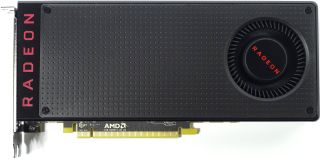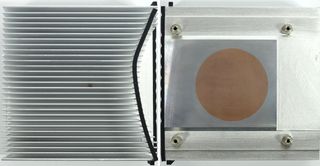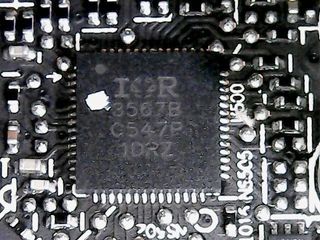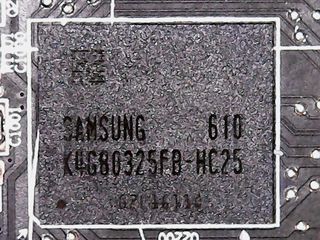AMD Radeon RX 480 8GB Review
The Radeon RX 480, Its Cooler & AMD's Board Design
At first glance, AMD’s newest graphics card looks a lot like the Radeon R9 Fury Nano. It weighs 685g, is 24.2cm long (end to end), 10.5cm tall (top of the motherboard’s PCIe slot to the top of the card) and is 3.5cm deep. A closer look reveals some cuts, though.

The black plastic cover consists of just one piece. Four indented hex screws make it look like there are more, but the shroud hides the fact that there aren't by using different surface structures and textures.

The top of AMD’s new graphics card sports the Radeon logo, which isn’t lit. There’s also a single six-pin auxiliary power connector up there. Really, AMD should have used an eight-pin connector, and we'll back that up with data when we start digging deeper into consumption.

The back of the RX 480 reveals that this card is really only 18cm long. Everything else hanging off the back is there for cooling. Interestingly, we’ve seen this design before...on an Nvidia board.

The cover is easy to pull off once you remove six screws on the side. The cooling solution underneath consists of a simple sink with fins, a larger frame responsible for cooling and stabilization, and the familiar radial fan, which tops out at 5000 RPM this time around. Taking off the shroud also reveals more of the board.

AMD's fan design pulls in air from your chassis and blows it through the card, exhausting out the rear I/O bracket. That can only mean one thing: Direct Heat Exhaust cooling. For the most part, the sink's body consists of a simple piece of extruded aluminum. In addition, there’s a small core of copper right above the GPU to increase heat transfer in that area. A strip is glued to the fins, ensuring airflow is directed through the fins and not above them.

The previously mentioned frame cools both the memory modules and power converter MOSFETs. Small fins provide some additional surface area in this section.
Stay on the Cutting Edge
Join the experts who read Tom's Hardware for the inside track on enthusiast PC tech news — and have for over 25 years. We'll send breaking news and in-depth reviews of CPUs, GPUs, AI, maker hardware and more straight to your inbox.


With the Radeon RX 480’s PCA laid bare, we see that the Polaris GPU is oriented diagonally. That's a familiar sight if you're familiar with older AMD graphics cards. Interestingly, the GPU doesn’t have any designation.


A closer look at the board reveals International Rectifier's IR 3567B. This component is also an old acquaintance; AMD has been using it ever since the Radeon R9 290's launch. It’s a PWM controller, which is to say that it’s the heart of the card’s digital power supply. AMD is sticking with a tried and true approach rather than following in Nvidia's footsteps with a newer and undocumented controller. Known protocols and interfaces make the job of writing the usual tools a whole lot easier.
AMD employs a rather unusual 6+1-phase design (it's puzzling because of the 150W TDP). For the six phases, AMD again diverges from Nvidia's implementation, which uses one dual-channel MOSFET per phase. Instead, the Radeon RX 480 utilizes two single-channel N-MOSFETs. One MDU1514 (30V, 66.3A, 6mΩ) and one MDU1511 (30V, 100A, 2.4mΩ) per phase are controlled by a single CHL8510 high-performance gate driver each.

The seventh phase supplies the memory modules with power using the PCIe slot’s 3.3V rail. This simplifies the design tremendously, especially since the memory modules don’t draw a lot of power. This design represents a return to the pre-Fiji era.

Fortunately, AMD also does away with a design decision that didn’t work out well for the Fiji-based boards. The gate drivers are no longer located right under the MOSFETs on the back of the PCA, eliminating troublesome hot spots.
AMD uses Samsung K4G80325FB-HC25 memory modules. These are the only ones available that offer 8Gb (32x 256Mb) per module. Their voltage comes in between 1.305 and 1.597V depending on clock rate, which can be up to a maximum of 2000MHz. These are the same memory modules Nvidia uses on its GeForce GTX 1070.
The back of the graphics card mostly consists of large air vents for exhaust. There apparently wasn’t enough room to include a DVI connector. Instead, there are three DisplayPort 1.3/1.4 outputs and one HDMI 2.0 port.

Overall, the Radeon RX 480’s design is conservative. Aesthetically and technically, it's nothing to write home about. If AMD wants to wow its customers with Polaris' looks, it'll either need to rely on board partners or another GPU entirely.
MORE: Best Motherboards
Current page: The Radeon RX 480, Its Cooler & AMD's Board Design
Prev Page The Display Controller, UVD, VCE & WattMan Next Page How We Tested Radeon RX 480-
chaosmassive this card will be my replacement of HD 7770 card for sure !Reply
thanks for the reviews, though power consumption from PCI slot is real concern here
-
asukafan2001 Seems like a decent card for what it is and what its target market is. Based off where the 1070 and 1080 fall in though i cant help but feel the 1060 which is targeted for the fall might make things uncomfortable for th 480. Nice to see amd working on power efficency though. That has always been a weakspot for them.Reply -
JeanLuc I can't help but think you need to revist this. The AOTS benchmark don't look right, the 480 is behind the 390, 390X and GTX980 in DX12.........I know this card is mid range and all that but it is 14nm with a revised chip design, surely it should be ahead of the last generation mid range cards even if it's by just a small amount.Reply
Edit: I stand corrected. Just looked at Anandtech and there results confirm what Toms is reporting. -
Oranthal Wow all the hype and it didn't deliver on any of it. Yes its an improvement but a marginal one and the supply is non existent. So its a paper launch as well. I was hoping this would be the solution to my 1440p 144hz freesync setup. Really disappointed, then again nothing lives up to online hype now. Nvidia's offerings hit the performance numbers we wanted but are insanely expensive. So I will keep waiting to see if drivers and oc's helps this card out or hope the 490 delivers.Reply
Edit: The cards are 100% available on newegg, I guess it took them until 9:30 to have them show up. I am still completely let down and hoping the partner cards and new drivers deliver on some performance gains. I guess its my fault for believing the hype that AMD could produce the same jump in the low to mid tier that Nvidia did for the high end. -
envy14tpe All that hype and finally the release....ahhh. We now have competition in the market place. The 960 and 970 have a good contender. Let's just hope price stays low as AMD doesn't play Nvidia's limited supply game.Reply
In Taiwan (where I am). There is one listing today selling the Gigabyte for $315usd. Prices need to get worked out. At that price I can get a 970.
-
rmpumper So basically AMD caught up to nvidia's now obsolete 9xx series? So much for the hype, though not unusual for AMD.Reply
Most Popular

